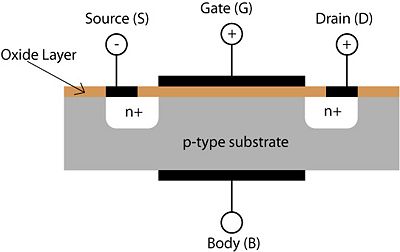Key Facts from Reading Chapter 1: Difference between revisions
Jump to navigation
Jump to search

(New page: The following facts are not profound and are possibly very obvious. Nonetheless, they might help cement certain concepts. Please add things you think would be helpful. ==Transistors== [[...) |
Michaelvier (talk | contribs) No edit summary |
||
| (7 intermediate revisions by 4 users not shown) | |||
| Line 13: | Line 13: | ||
*A noninverting amplifier has a positive voltage gain, <math>\ {A_{v}}</math>. (If you get this, you deserve a cookie) |
*A noninverting amplifier has a positive voltage gain, <math>\ {A_{v}}</math>. (If you get this, you deserve a cookie) |
||
*The power gain,<math>\ G</math>, is the ration of the output power to the input power |
*The power gain,<math>\ G</math>, is the ration of the output power to the input power |
||
**<math>G=\frac{P_{o}}{P_{i}}=\frac{V_o{I_o}}{ |
**<math>G=\frac{P_{o}}{P_{i}}=\frac{V_o{I_o}}{V_i{I_i}}=A_v{A_{i}}=(A_v)^2\frac{R_{i}}{R_{L}}</math> |
||
***<math>\ R_i</math> is the amplifier's input resistance and <math>\ R_o</math> is the amplifier's output resistance. |
***<math>\ R_i</math> is the amplifier's input resistance and <math>\ R_o</math> is the amplifier's output resistance. |
||
==Decibel Conversion== |
==Decibel Conversion== |
||
*Power gain, <math>\ G</math>, can be converted to decibels: |
*Power gain, <math>\ G</math>, can be converted to decibels: |
||
| Line 24: | Line 25: | ||
<math>\ G_{db}=10 log |A_v|+10 log R_i - 10 log R_L</math> |
<math>\ G_{db}=10 log |A_v|+10 log R_i - 10 log R_L</math> |
||
*By the equation above, we can say voltage gain in decibels can be found with this equation: <math>\ A_{v dB}=20 log |A_v|</math>, where <math>\ A_v</math> is the voltage gain and <math>\ A_{v dB}</math> is the voltage gain is decibels. |
*By the equation above, we can say voltage gain in decibels can be found with this equation: <math>\ A_{v dB}=20 log |A_v|</math>, where <math>\ A_v</math> is the voltage gain and <math>\ A_{v dB}</math> is the voltage gain is decibels. |
||
*Similarly, we can say current gain in decibels can be found with this equation: <math>\ A_{i dB}=20 log |A_i|</math>, where <math>\ A_i</math> is the current gain and <math>\ A_{i dB}</math> is the current gain |
*Similarly, we can say current gain in decibels can be found with this equation: <math>\ A_{i dB}=20 log |A_i|</math>, where <math>\ A_i</math> is the current gain and <math>\ A_{i dB}</math> is the current gain in decibels. |
||
==Differential Amplifiers== |
==Differential Amplifiers== |
||
| Line 31: | Line 32: | ||
*The output of an ideal differential amplifier is given by <math>\ v_o=A_d v_{id} </math>. |
*The output of an ideal differential amplifier is given by <math>\ v_o=A_d v_{id} </math>. |
||
*The common-mode input signal is given by the following: <math>v_{icm}=\frac{1}{2}(v_{i1}+v_{i2})</math>. |
*The common-mode input signal is given by the following: <math>v_{icm}=\frac{1}{2}(v_{i1}+v_{i2})</math>. |
||
*A real differential amplifier's output is given by <math>\ v_o=A_d v_{id}+A_{cm} v_{icm} </math>, where <math>A_{cm}</math> is the common-mode signal gain. |
*A real differential amplifier's output is given by <math>\ v_o=A_d v_{id}+A_{cm} v_{icm} </math>, where <math>\ A_{cm}</math> is the common-mode signal gain. |
||
==References== |
==References== |
||
| Line 37: | Line 38: | ||
==Contributors== |
==Contributors== |
||
[[Lau, Chris | Christopher Garrison Lau I]] |
*[[Lau, Chris | Christopher Garrison Lau I]] |
||
==Readers== |
|||
*[[Shepherd,Victor]] |
|||
==Reviewers== |
|||
*[[Ben Henry|Henry,Ben]] |
|||
*[[Michael Vier|Vier, Michael]] |
|||
*The sentence that says "voltage gain and is the voltage gain is decibels." I think you mean "in decibels." Other than that nice work! |
|||
Latest revision as of 20:24, 28 February 2010
The following facts are not profound and are possibly very obvious. Nonetheless, they might help cement certain concepts. Please add things you think would be helpful.
Transistors

MOSFET diagram <ref> University of Cambridge </ref>
- Conduction in n-type material is from free electrons.
- Conduction in p-type material is from holes (positive particles).
- The function of metal-oxide-semiconductor field-effect transistors (MOSFETs) depends on the voltage applied to the gate.
- Certain ranges of voltage allow no current to flow between the drain and the source. In this way, the MOSFET acts like an open switch.
- Another particular range of voltage allows current to easily flow from the source to the drain.
- When the voltage is in between the ranges of open and closed switch, the MOSFET can smoothly control the amount of current flowing.
- Bipolar Junction Transistors (BJTs) can act as either switches or current controls as well.
Amplifiers
- An inverting amplifier has a negative voltage gain, .
- A noninverting amplifier has a positive voltage gain, . (If you get this, you deserve a cookie)
- The power gain,, is the ration of the output power to the input power
-
- is the amplifier's input resistance and is the amplifier's output resistance.
-
Decibel Conversion
- Power gain, , can be converted to decibels:
- By the equation above, we can say voltage gain in decibels can be found with this equation: , where is the voltage gain and is the voltage gain is decibels.
- Similarly, we can say current gain in decibels can be found with this equation: , where is the current gain and is the current gain in decibels.
Differential Amplifiers
- Differential Amplifiers have two inputs. The terminal marked with a "+" is the noninverting input, and the terminal marked with a "-" is the inverting input.
- The differential input signal is given by
- The output of an ideal differential amplifier is given by .
- The common-mode input signal is given by the following: .
- A real differential amplifier's output is given by , where is the common-mode signal gain.
References
<references/>
Contributors
Readers
Reviewers
- The sentence that says "voltage gain and is the voltage gain is decibels." I think you mean "in decibels." Other than that nice work!


















